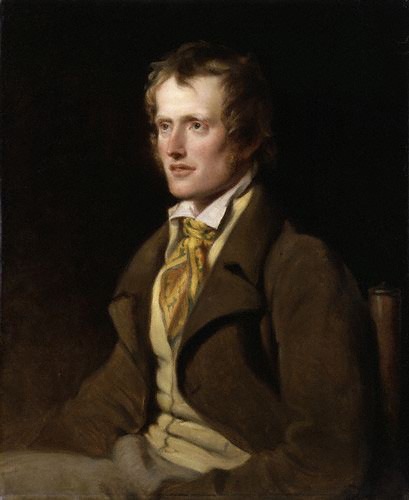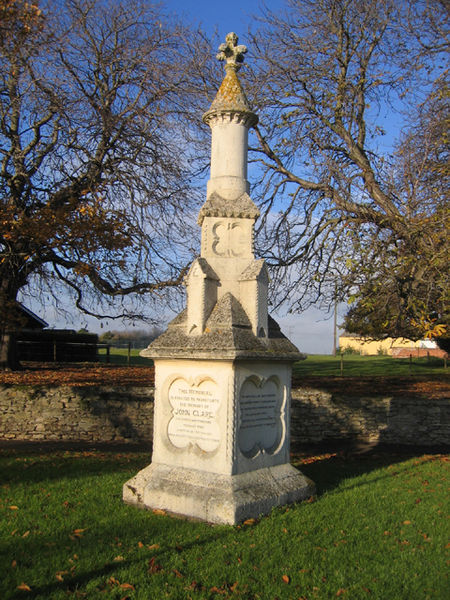<Back to Index>
- Ethnographer Stewart Culin, 1858
- Poet John Clare, 1793
- Empress consort of All the Russias Alexandra Feodorovna, 1798
PAGE SPONSOR


John Clare (13 July 1793 – 20 May 1864) was an English poet, born the son of a farm labourer who came to be known for his celebratory representations of the English countryside and his lamentation of its disruption. His poetry underwent a major re-evaluation in the late 20th century and he is often now considered to be among the most important 19th century poets. His biographer Jonathan Bate states that Clare was "the greatest labouring class poet that England has ever produced. No one has ever written more powerfully of nature, of a rural childhood, and of the alienated and unstable self".
Clare was born in Helpstone (now Helpston) which, at the time of his birth, was in the Soke of Peterborough, Northamptonshire, six miles to the north of Peterborough. Today this lies just inside the northern limit of Cambridgeshire, boundaries having changed since Clare's day. He became an agricultural labourer while still a child, however he attended school in Glintonchurch until he was twelve.
In his early adult years, Clare became a pot boy in the Blue Bell public house and fell in love with Mary Joyce; but her father, a prosperous farmer, forbade her to meet him. Subsequently he was a gardener at Burghley House. He enlisted in the militia, tried camp life with Gypsies, and worked in Pickworth as a lime burner in 1817. In the following year he was obliged to accept parish relief. Malnutrition stemming from childhood may be the main culprit behind his 5-foot stature and may have contributed to his poor physical health in later life.
Clare had bought a copy of Thomson's Seasons and
began to write poems and sonnets. In an attempt to hold off his
parents' eviction from their home, Clare offered his poems to a local
bookseller named Edward Drury. Drury sent Clare's poetry to his cousin
John Taylor of the publishing firm of Taylor & Hessey, who had
published the work of John Keats. Taylor published Clare's Poems Descriptive of Rural Life and Scenery in 1820. This book was highly praised, and in the next year his Village Minstrel and other Poems were published. He had married Martha ("Patty") Turner in 1820. An annuity of 15 guineas from the Marquess of Exeter,
in whose service he had been, was supplemented by subscription, so that
Clare became possessed of £45 annually, a sum far beyond what he
had ever earned. Soon, however, his income became insufficient, and in
1823 he was nearly penniless. The Shepherd's Calendar (1827) met with little success, which was not increased by his hawking it
himself. As he worked again in the fields his health temporarily improved; but he soon became seriously ill. Earl FitzWilliam presented him with a new cottage and a piece of ground, but Clare could not settle in his new home. Clare
was constantly torn between the two worlds of literary London and his
often illiterate neighbours; between the need to write poetry and the
need for money to feed and clothe his children. His health began to
suffer, and he had bouts of severe depression, which became worse after
his sixth child was born in 1830 and as his poetry sold less well. In
1832, his friends and his London patrons clubbed together to move the
family to a larger cottage with a smallholding in the village of Northborough, not far from Helpston. However, he felt only more alienated. His last work, the Rural Muse (1835), was noticed favorably by Christopher North and
other reviewers, but this was not enough to support his wife and seven
children. Clare's mental health began to worsen. As his alcohol
consumption steadily increased along with his dissatisfaction with his
own identity, Clare's behaviour became more erratic. A notable instance
of this behaviour was demonstrated in his interruption of a performance
of The Merchant of Venice, in which Clare verbally assaulted Shylock.
He was becoming a burden to Patty and his family, and in July 1837, on
the recommendation of his publishing friend, John Taylor, Clare went of
his own volition (accompanied by a friend of Taylor's) to Dr Matthew
Allen's High Beach Private Asylum near Loughton, in Epping Forest. Taylor had assured Clare that he would receive the best medical care. During his first few asylum years in Essex (1837 – 1841), Clare re-wrote famous poems and sonnets by Lord Byron. His own version of Child Harold became a lament for past lost love, and Don Juan, A Poem became an acerbic, misogynistic, sexualised rant redolent of an aging Regency dandy. Clare also took credit for Shakespeare's plays, claiming to be the Renaissance genius himself. "I'm John Clare now," the poet claimed to a newspaper editor, "I was Byron and Shakespeare formerly." In
1841, Clare left the asylum in Essex, to walk home, believing that he
was to meet his first love Mary Joyce; Clare was convinced that he was
married with children to her and Martha as well. He did not believe her
family when they told him she had died accidentally three years earlier
in a house fire. He remained free, mostly at home in Northborough, for
the five months following, but eventually Patty called the doctors in.
Between Christmas and New Year in 1841, Clare was committed to the Northamptonshire County General Lunatic Asylum (now St Andrew's Hospital). Upon Clare's arrival at the asylum, the accompanying doctor, Fenwick Skrimshire, who had treated Clare since 1820, completed
the admission papers. To the enquiry "Was the insanity preceded by any
severe or long continued mental emotion or exertion?", Dr. Skrimshire
entered: "After years of poetical prosing." He remained here for the rest of his life under the humane regime of Dr Thomas Octavius Prichard, encouraged and helped to write. Here he wrote possibly his most famous poem, I Am. He
died on 20 May 1864, in his 71st year. His remains were returned to
Helpston for burial in St Botolph’s churchyard. Today, children at the
John Clare School, Helpston's primary, parade through the village and
place their 'midsummer cushions' around Clare's gravestone (which has
the inscriptions "To the Memory of John Clare The Northamptonshire
Peasant Poet" and "A Poet is Born not Made") on his birthday, in honour
of their most famous resident. The
thatched cottage where he was born was bought by the John Clare
Education & Environment Trust in 2005 and is restoring the cottage
to its 18th century state. In his time, Clare was commonly known as "the Northamptonshire Peasant Poet". Since his formal education was brief, Clare resisted the use of the increasingly standardised English grammar and orthography in
his poetry and prose. Many of his poems would come to incorporate terms
used locally in his Northamptonshire dialect, such as 'pooty' (snail),
'lady-cow' (ladybird), 'crizzle' (to crisp) and 'throstle' (song thrush). In
his early life he struggled to find a place for his poetry in the
changing literary fashions of the day. He also felt that he did not
belong with other peasants. Clare once wrote "I
live here among the ignorant like a lost man in fact like one whom the
rest seemes careless of having anything to do with — they hardly dare
talk in my company for fear I should mention them in my writings and I
find more pleasure in wandering the fields than in musing among my
silent neighbours who are insensible to everything but toiling and
talking of it and that to no purpose." It
is common to see an absence of punctuation in many of Clare's original
writings, although many publishers felt the need to remedy this
practice in the majority of his work. Clare argued with his editors
about how it should be presented to the public. Clare grew up during a period of massive changes in both town and countryside as the Industrial Revolution swept
Europe. Many former agricultural workers, including children, moved
away from the countryside to over crowded cities, following factory
work. The Agricultural Revolution saw pastures ploughed up, trees and hedges uprooted, the fens drained and the common land enclosed. This destruction of a centuries old way of life distressed Clare deeply. His political and social views were predominantly conservative ("I
am as far as my politics reaches 'King and Country' — no Innovations in
Religion and Government say I."). He refused even to complain about the
subordinate position to which English society relegated him, swearing
that "with the old dish that was served to my forefathers I am content." His early work delights both in nature and the cycle of the rural year. Poems such as Winter Evening, Haymaking and Wood Pictures in Summer celebrate
the beauty of the world and the certainties of rural life, where
animals must be fed and crops harvested. Poems such as Little Trotty Wagtail show his sharp observation of wildlife, though The Badger shows
his lack of sentiment about the place of animals in the countryside. At
this time, he often used poetic forms such as the sonnet and the
rhyming couplet. His later poetry tends to be more meditative and use
forms similar to the folks songs and ballads of his youth. An example
of this is Evening. His knowledge of the natural world went far beyond that of the major Romantic poets. However, poems such as I Am show a metaphysical depth
on a par with his contemporary poets and many of his pre-asylum poems
deal with intricate play on the nature of linguistics. His 'bird's nest
poems', it can be argued, illustrate the self-awareness, and obsession
with the creative process that captivated the romantics. Clare was the
most influential poet, aside from Wordsworth to practice in an older style. Clare was relatively forgotten during the later nineteenth century, but interest in his work was revived by Arthur Symons in 1908, Edmund Blunden in 1920 and John and Anne Tibble in their ground breaking 1935 2 volume edition. Benjamin Britten set some of 'May' from A Shepherd's Calendar in his Spring Symphony of 1948. Copyright
to much of his work has been claimed since 1965 by the editor of the
Complete Poetry (OUP, 9 vols., 1984 – 2003), Professor Eric Robinson,
though these claims have been contested. With recent publishers
refusing to acknowledge the claim (especially in recent editions from
Faber and Carcanet), it seems the copyright is now defunct. Today the largest collection of original Clare manuscripts are housed at Peterborough Museum,
where they are available to view by appointment. The John Clare Trust
purchased Clare Cottage in Helpston in 2005, preserving it for future
generations. The Cottage has been restored, using traditional building
methods, to create a centre where people can learn about John Clare,
his works, how rural people lived in the early 19th century and also
gain an understanding of the environment. Since
1993, the John Clare Society of North America has organized an annual
session of scholarly papers concerning John Clare at the annual
Convention of the Modern Language Association of America.